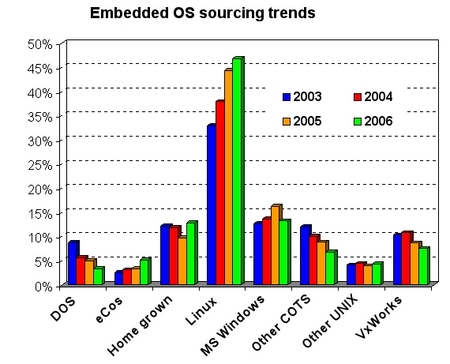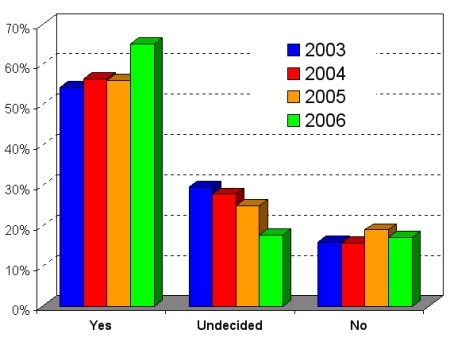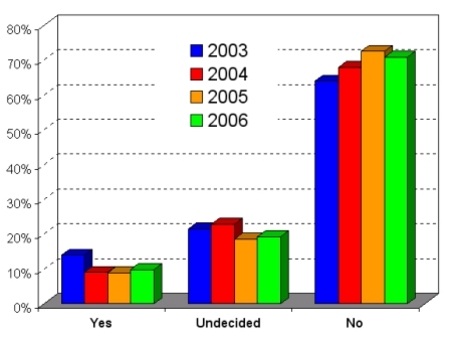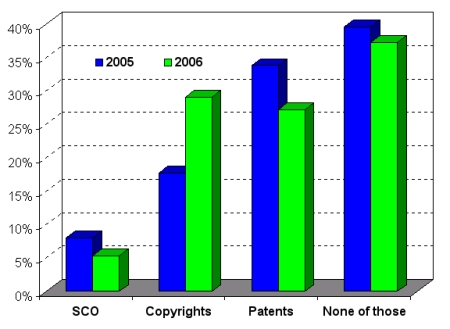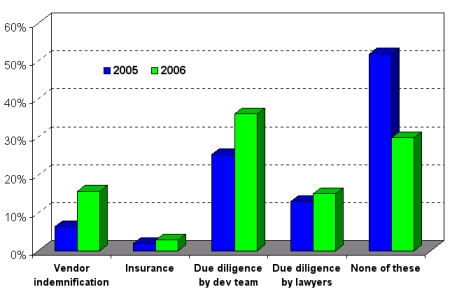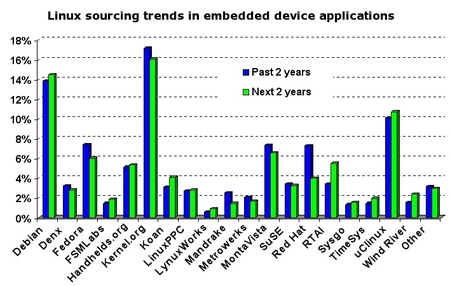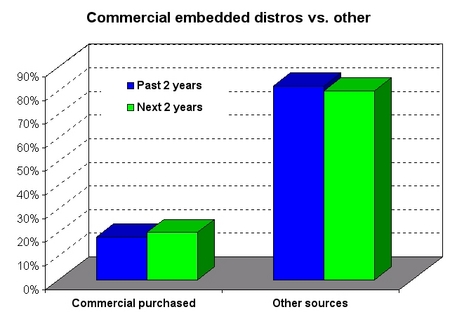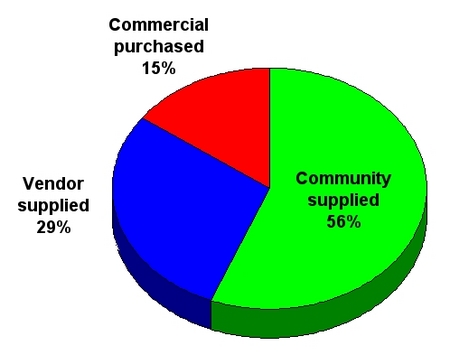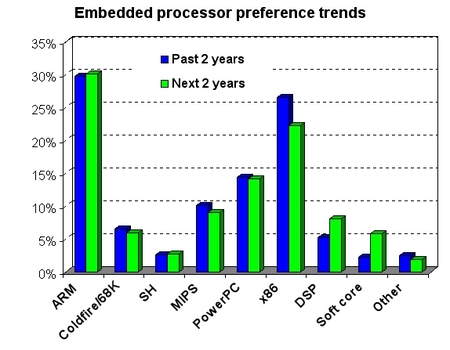Snapshot of the embedded Linux market — May, 2006
May 25, 2006 — by LinuxDevices Staff — from the LinuxDevices Archive — 5 views The results of LinuxDevices.com's sixth annual Embedded Linux Market Survey are in! This brief summary outlines our interpretation of a few key data points. Overall, we find the results encouraging for embedded Linux, and for companies in the embedded Linux OS and tools market.
The results of LinuxDevices.com's sixth annual Embedded Linux Market Survey are in! This brief summary outlines our interpretation of a few key data points. Overall, we find the results encouraging for embedded Linux, and for companies in the embedded Linux OS and tools market.
This year, our survey drew 853 respondents, or 78 more than last year over a comparable period of time. This alone shows that interest in embedded Linux continues to grow, a fact also reflected by the growing readership attracted by our Website and opt-in newsletter.
As we do every year, we encourage readers to draw their own conclusions from the complete survey response data. Last year's (2005's) summary findings and complete data and are also available for comparison, along with those from years past and many other market research reports (see the “For further research” section below).
Please note that while we make every effort to increase result validity by limiting responses to a single submission per IP address, respondents are self-selected, and we have minimal control over multiple or dishonest voting. Additionally, our market share results are not meant to reflect upon the commercial success of individual companies. For commercial marketshare figures, LinuxDevices.com recommends VDC, EDC, IDC, ABI, and Gartner, among other capable sources.
And now, our latest observations . . .
Linux has truly established itself as a viable if not dominant embedded operating system that is used in thousands of new designs each year. Our survey results over the past four years show that Linux adoption is still on the rise, although uptake has certainly slowed since the “boom” years in the early part of the decade. This year's survey results suggest that 47 percent of our survey's respondents have used Linux in embedded projects and/or products — a growth of about two percentage points over last year's results.
Which OSes have been in your (company's) embedded designs during the past two years?
Our survey results suggest that while Linux continues to gain popularity, traditional embedded OSes and RTOSes (real-time operating systems) may be losing marketshare. Along with DOS and “other COTS” (commercial off the shelf) OSes/RTOSes, interest in VxWorks, the RTOS marketshare leader, appears to be falling off somewhat, perhaps helping to explain Wind River's decision to embrace Linux as a core OS strategy. Even embedded Windows (including all variants) lost ground in this year's survey results, with only the open source eCos, an RTOS for deeply embedded systems, and “home grown” approaching Linux's popularity gains.
Each year, we ask about planned OS use over the next two years, as well as actual OS use over the previous two. In the early days, planned use far surpassed actual use. Today, as more and more project teams succeed in executing their Linux migration strategies, the Linux “uptake gap” has narrowed dramatically. Trend lines on the chart below suggest that by decade's end, actual and planned Linux use will converge, at about 60 percent.
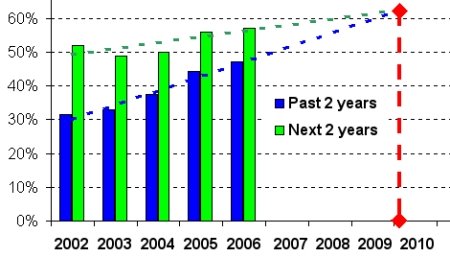
Actual and planned Linux use may converge by decade's end
The single most notable trend to emerge from this year's survey data may be an apparent increase in the willingness of respondents to pay for embedded Linux development and support services.
For the last three years, only slightly more than half of respondents have affirmed their willingness to pay for support. In 2003, 54 percent said they would consider it; in 2004, 55 percent; and in 2005, 53 percent. This year, however, nearly two-third of respondents — 65 percent — said they are willing to consider commercial support and development services.
Would you consider paying for support or services?
On the other hand, per-unit royalty payments continue to be unpopular, with nearly three-fourths of respondents not willing to consider them at all.
Would you consider paying per-unit royalties?
Another fairly large trend this year appears to be growing awareness and concern regarding the legal obligations of using open source software, especially with regard to potential copyright violations.
Last year, only 18 percent of respondents said they were concerned about potential copyright infringments. This year, the number who expressed concerned skyrocketed to 29 percent.
In contrast, concerns about patent infringements actually dropped, from 34 percent to 27 percent, as did concerns about SCO (from eight to five percent).
Which of these legal issues do you (or your company) feel are a significant concern in using embedded Linux?
As devices become more and more complex, and more software goes into them, companies and developers face a greater burden of legal due diligence. And, companies appear to be taking that burden seriously.
Asked how their company was dealing with legal concerns related to open source licensing, 36 percent cited “due diligence by development team” this year, compared with just 25 percent last year. “Due diligence by lawyers” also got more responses this year — 15 percent, compared to 13 percent last year. And, “indemnification provided by your Linux or system vendor” shot way up, from just six percent last year, to 16 percent this year.
How is your company dealing with legal concerns relating to embedded Linux?
Each year, we try to identify the most popular commercial and non-commercial sources of embedded Linux among our readers. This year's results suggest that little has changed since last year, when we wrote:
Taken as a whole, the embedded Linux landscape seems most noteworthy for the large variety of popular sourcing options, rather than for the dominance of any single vendor or organization. This suggests that Linux continues to deliver on the promise of vendor neutrality and absence of vendor lock-in, and that embedded Linux technology remains adequately decoupled from the fortunes or failings of any single company or organization.
What sources of Linux were used in your (company's) embedded designs during the past two years? The next two years?
(Click image to enlarge)
In past surveys, we tried to guess at the percentage of developers using paid-for, commercially sourced and supported Linux distributions, based on answers to various questions. This year, we decided to simply ask the question outright.
How did you obtain your (company's) embedded Linux software during the past two years? The next two years?
We had long suspected that the vast majority of embedded Linux developers do not pay anything for their OS, and this year's results support that suspicion, with only 17 percent actually purchasing Linux from a commercial vendor, and only 18 percent planning to do so within the next two years.
“Purchased from commercial embedded Linux vendor” vs. obtained in some other manner
By far the greatest number of embedded Linux developers appear to download the OS from community sources, receive the OS from a hardware vendor, or download a free version from a commercial Linux provider's website. Despite getting their Linux code for free, these developers may still represent a significant commercial opportunity, however, given that developers appear increasingly willing to pay for support, as noted above.
The LinuxDevices editors have not been alone in noting the preponderance of freely downloaded distributions among embedded Linux developers. TimeSys last August decided to drop its distribution-based business model, in favor of an online support service aimed precisely at the “roll-your-own” Linux developer sourcing Linux from various freely available sources. The move has apparently been well received, as the company reported surpassing 2,000 subscribers in March.
More embedded Linux developers than ever before appear to be using commercial development tools. This year, only 56 percent of respondents reported using free tools, down from 59 percent in 2005. Tools “supplied by selected embedded Linux vendor” held more or less steady, dropping slightly from 29 to 28 percent of respondents. Meanwhile, “commercial tools from tools specialists” jumped from 9 percent of respondents last year to around 15 percent this year.
What development tools do you expect to use?
Tool satisfaction appears to be up slightly as well. Thirty percent of respondents found their development tools “very good,” this year, up from 27 percent last year. However, this year, like last year, 10 percent described their tools as “inadequate.”
Last year, ARM displaced x86 as the most frequently deployed embedded architecture. Some 30 percent of projects were based on ARM, while 28 percent used x86. However, both ARM and x86 use grew, year-over-year, at the expense of every other architecture except PowerPC.
This year, ARM remained the top architecture, followed once more by x86 in second place. However, ARM use actually dropped a percentage point, to 29, while x86 fell two points, to 26 percent.
Meanwhile, MIPS was the top gainer, shooting from 7 percent use in last year's survey, to 10 percent this year, possibly fueled by more set-top box, media adapter, and wireless access point designs. All other architectures, including PowerPC, stayed flat, essentially.
What CPU(s) have been in your (company's) embedded designs during the past two years? The next two?
Another noteworthy trend is that respondents seem keen to explore the use of FPGA-based “soft core” embedded processors in the near future, as indicated on the above graph that compares actual use over the past two years with expected use during the coming two years.
As in the past, our annual market snapshot merely touches on the most salient results, in our view, of the latest reader survey. As always, we encourage you to review the complete results to take a look at the complete data set, review our prior survey results, and let us know what YOU find interesting, using the Talkback thread below.
Share your response to our observations above, or post your own analysis based on our complete response data, by going here:
Research findings from various analysts:
- Embedded Linux market growing significantly, research firm says
- e-Seminar includes key embedded Linux market data
- Linux now top choice of embedded developers
- Linux poised to dominate world mobile handset market
- Linux trounces Windows Mobile in smartphone shipments
- VDC: mobile dev times longer, less predictable with Linux
- VDC: Microsoft top embedded vendor
- Linux squeezing WinCE, VxWorks out of devices
- Gartner/Dataquest: Embedded Linux now number one in Asia
- EDC: Embedded Linux remains #1 choice of developers — despite tools dissatisfaction
- Findings from EDC's Embedded Developer Survey — August, 2003
- Linux, Windows neck-and-neck in embedded
- Embedded Linux tops developers' 2002 wishlist
- Study finds 300% growth in Embedded Linux
- Interest in Embedded Linux skyrockets
- Whitepaper: Linux's Future in the Embedded Market
- Update on the Embedded Linux Market
Reports and data from past LinuxDevices.com surveys:
- Snapshot of the Embedded Linux market — May, 2005
- Snapshot of the Embedded Linux market — March, 2004
- Snapshot of the Embedded Linux Market — May, 2003
- What's so good about open source and Linux — in embedded? (2001 survey results)
- Archive of earlier LinuxDevices.com survey data
Other related stories:
- Anomalous embedded Linux survey results reported, retorted
- Two billion unit device market tilts toward off-the-shelf software
- The Great Gadget Smack-Down
This article was originally published on LinuxDevices.com and has been donated to the open source community by QuinStreet Inc. Please visit LinuxToday.com for up-to-date news and articles about Linux and open source.
